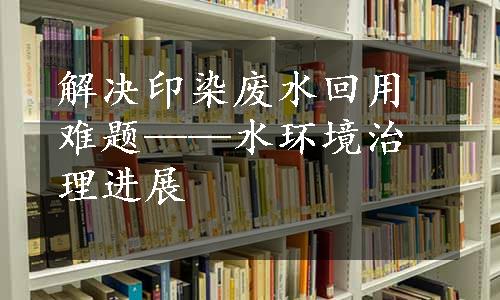
Water Environment Treatment
工业水污染控制与资源化
Control and Reuse of Industrial Water Pollution
随着环保的理念、要求、压力的提升,印染废水处理、回用要求逐年提高,印染企业也跟着不停改造,处于“疲于奔命”状态。我国水环境污染面临严峻考验,国家开展了大量的水环境综合整治工作,而且国际上(例ZDHC——有害化学品零排放组织)也要求有害化学品零排放,其远期排放标准基本要求接近地表水Ⅲ类要求。因此,通过膜分离技术深度处理后回用,甚至废水零排放成为印染企业环保发展新趋势。新型实用的高浓度有机废水处理及资源化工艺具有非常广阔的应用前景。
In the context of increasing demand and pressure for environmental protection, and, the requirements of dyeing waste water treatment and reuse has seen a rise year by year. Printing and dyeing enterprises are also struggling to follow the momentum. Above all, some international organizations,such as ZDHC (The Zero Discharge of Hazardous Chemicals)require zero emissions of hazardous chemicals, and the longterm emission standard is required to be close to surface water ClassⅢ requirements. Therefore, through the membrane separation technology after the advanced treatment of reuse, and even zero discharge of waste water into the printing and dyeing plants to develop new trends in environmental protection. Novel and practical high concentration organic waste water treatment and recycling technologies has a very broad application prospects.
厌氧-微藻联合资源化处理高浓度有机废水新工艺
Novel Process of Anaerobic in Combination with Micro-algae for Recycling of High Concentration Organic Waste Water
开发了“高效厌氧发酵+微藻富集净化+动态膜深度处理”高浓度有机废水三步法资源化处理新工艺,将高浓度有机废水高效厌氧发酵转化、微藻培养用于高浓度有机废水处理、藻水分离液经动态膜反应器深度处理回用相结合,解决了传统高浓度有机废水四步法处理存在的资源利用低、二次污染严重等问题,实现了高浓度有机废水处理从单纯污染处理到资源循环利用的变革。
By combining efficient anaerobic fermentation and microalgae culture for high concentration organic waste water treatment with the subsequent advanced treatment and reuse of the microalgaewater separating liquid by dynamic membrane reactor, we invented a new three-step recycling technology for high concentration organic waste water, namely, “Efficient anaerobic fermentation +microalgae enrichment and purification + dynamic membrane advanced treatment”. This technology successfully solved the low resource utilization,secondary pollution and other problems of the traditional Four-step technology and thus delivers the transformation of high concentration organic waste water treatment from simple pollution treatment to resource recycling.
厌氧发酵出水中污染物质培养微藻光生物反应器
Photobioreactors of cultivating microalgae by the pollutants in the effluent of anaerobic fermentation
印染废水大通量膜处理及回用技术与产业化
Printing and Dyeing Waste water Resource-orientated Treatment Technologies of High-flux Membrane for Industrialization Application
工业废水处理后的回用量极大,而且回用水的水质标准在不少方面可以降级并使用于部分工艺,因此,开发大通量、低成本的膜具有十分重要的理论意义和实用价值。经研究发现,对于多组分膜,组分间相容性好则孔径小,强度高;相容性差则孔径大,强度低,这关键就在于寻找最佳的平衡点。同时还要考虑材料价格,尽量使复合纤维膜的成本比同类产品低廉,实现这些目标技术难度较大。
The industrial waste water has large reflux flow quantity, and the water quality standard of reuse is able to apply in part of technology in some respects downgraded, therefore, developing membrane with high flux and lowcost has great theoretical significance and practical value. The study found that, for multi-component membrane,if compatibility between components is well, pore diameter is small and membrane strength is high, larger pore diameter and lower strength. So the key point is finding the best balance point. In the meantime material price makes up of the cost of composite fiber membrane. How can the price be lowered compared to that of congeneric products? It is difficult to develop these technologies.
开发了稀土催化氧化技术,利用稀土元素的特性(如最外层电子极不稳定,电子云转移迅速,离子价位跳跃产生一定量的负压实现能级转换),起到催化作用和高氧化能力。实践表明,该技术可明显提高氧离子在水中的传递速率,加速废水液中无机离子和有机化合物与溶解氧反应,在达到等电位后,又能强化絮凝作用,加速污染物沉淀。(www.xing528.com)
Rare earth catalytic oxidation technology takes advantage of characteristics of rare earth elements (Such asunstable outermost electrons, and electronic cloud moves quickly and ion price jumps produce a certain amount of negative pressure to achieve energy level conversion) to play a catalytic role and high oxidation capacity. Good practice dictates that it can significantly improve oxygen ions in water transfer rate and speed up the waste water in inorganic ions and organic compounds and dissolved oxygen reaction. After reaching equipotential, it can strengthen the flocculation effect and accelerate precipitation of pollutants.
含硫含碱废液过程减排新技术及在化工行业中应用
New Technology of Reducing Emission of Sulfur and Alkali in Waste water and Its Application in Chemical Industry
以膨化剂延缓固形物沉降,降低废碱液焚烧成本;以饱和碱液做媒质,使熔碱雾化-冷却-结晶协同进行,高浓度废碱液的碱回收率由70%提高到约100%,无废水排放,实现“饱和碱液封闭循环,熔碱全回”。
The technology includes to delay precipitation of solid matter with expansion agent, to lower cost of waste alkali incineration, to atomize melting alkali with medium of saturated lye, realizing synergy of alkali atomization-cooling-crystallization and lifting reuse rate of high concentration alkali from 70% to about 100%. It achieves the goal of no waste water discharge, and “closed recycling loop of saturated alkaline solution”.
该技术使环己酮生产过程中的碱消耗量减少30%,产量增加8%;使甲基叔丁基醚生产过程中的催化剂单耗降低40%,离子保护剂连续运转周期提高4倍;使含硫废液汽提塔蒸汽消耗量从0.22吨/吨废水降低到0.12吨/吨,汽提过程的连续稳定运转周期提高1倍。
含硫含碱废液过程减排新技术及在化工行业中应用
New technology for reducing sulfur containing alkali waste liquid and its application in chemical industry
This technology makes 30% less alkali consumption and 8% more production in cyclohexanone production;40% less catalysts consumption in methyl tert-butyl ether production; continuous operation time of Ion protection agent increased by 4 times; steam consumption in sulfur-containing waste stripping tower reduced from 0.22 tons/ton of waste water to 0.12 tons/ton; continuous stable operation time of stripping process doubled.
通过产学研合作,配套技术和装置在上海、浙江、山东、江西等省市的近20处高浓度工业有机废水和200多处养殖场粪污水处理项目中得到广泛推广,有力推动了我国高浓度有机废水处理行业的产业升级。
University-industry cooperation promotes techniques and devices nationwide in nearly 20 high concentration industrial organic waste water projects and over 200 dung waste water treatment projects in livestock farm, widely scattered around Shanghai, Zhejiang, Shandong, Jiangxi and other provinces, which vigorously promote the industrial upgrade of high concentration organic waste water treatment in China.
该项目共申请国家发明专利18项,授权15项,部分成果被中华人民共和国环境保护标准《纺织染整工业水污染物排放标准》(GB4287)、《印染行业废水治理技术规范》、《印染行业清洁生产评价指标体系》等采用。研究技术在江苏、浙江、山东、广东、福建等21家企业应用,近3年为企业节支近7 000万元,减排印染废水16万吨,为打造我国绿色纺织又增添了新力量。
This project has applied for 18 national invention patents, 15 of which have been authorized and adopted in Environmental Protection Standards of the People’s Republic of China, such as Standard for Pollutant Discharge of Textile Dyeing and Finishing Industry (GB4287), Printing and Dyeing Industry Waste Water Treatment Technology Specification, Evaluation Index System of Cleaner Production in Printing and Dyeing Industry and many more. Related techniques are applied in 21 enterprises in provinces of Jiangsu, Zhejiang Shandong,Guangdong and Fujian, with reduced COD emissions of 160 000 tons and reduced printing and dyeing waste water of 160 000 tons, slashing manufacturing expenses of nearly 70 million RMB. All above contributes to building a greener textile industry.
(同济大学和中国环境科学研究院等单位供稿,朱昊辰等整理)
(Contributed by Tongji University and Chinese Research Academy of Environmental Sciences,sorted by Zhu Haochen)
免责声明:以上内容源自网络,版权归原作者所有,如有侵犯您的原创版权请告知,我们将尽快删除相关内容。




